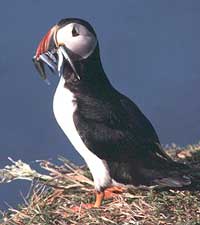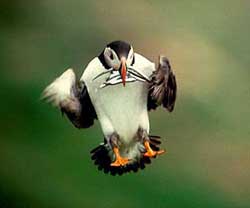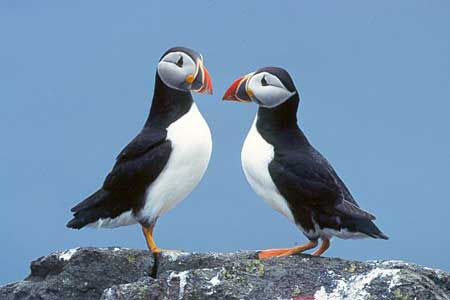The Atlantic Puffin, scientifically known as Fratercula arctica, is one of the most peculiar seabirds found in the Atlantic Ocean. This bird primarily lives in marine environments (except during the breeding season) and exhibits remarkable adaptations for life at sea.
 Fratercula arctica is an excellent swimmer; when submerged, they flap their wings to propel themselves as if flying underwater, while using their feet to steer. Regardless of weather conditions, these birds can be seen flying, swimming, diving, or drifting on the waves throughout the year. In the open sea, puffins feed on fish and other marine invertebrates.
Fratercula arctica is an excellent swimmer; when submerged, they flap their wings to propel themselves as if flying underwater, while using their feet to steer. Regardless of weather conditions, these birds can be seen flying, swimming, diving, or drifting on the waves throughout the year. In the open sea, puffins feed on fish and other marine invertebrates.
Most puffins spend the winter far from shore, although a few may migrate to warmer areas. During the breeding season, Atlantic Puffins leave the water and head to land to nest and incubate their eggs. They typically gather in large colonies for breeding from April to August. These seabirds prefer to nest in soft, unfrozen soil on cliff ledges or islands. They often utilize burrows abandoned by rabbits or other puffins and occasionally dig their own small nests by using their feet to excavate soil between rocks or in grassy areas.
Female Fratercula arctica usually lays one egg (though occasionally two), and primarily the female incubates the egg, which takes about 40-43 days to hatch. Most seabirds feed their chicks by regurgitating food, but puffins often provide whole fish to their young.
What is most astonishing is their ability to catch multiple fish in a single dive, storing them horizontally in their beaks before flying back to the nest to feed their chicks.
 Previously, it was believed that parent birds abandoned their chicks in the nest at the end of the breeding season to return to the sea. However, the truth is that parent puffins care for their chicks until they are fully feathered and capable of flying out to sea—this usually happens at night. Once at sea, the chicks must learn to fend for themselves. They reach maturity around the age of 4-5 years, at which point they sport a red ring around their eyes and a yellow-orange beak.
Previously, it was believed that parent birds abandoned their chicks in the nest at the end of the breeding season to return to the sea. However, the truth is that parent puffins care for their chicks until they are fully feathered and capable of flying out to sea—this usually happens at night. Once at sea, the chicks must learn to fend for themselves. They reach maturity around the age of 4-5 years, at which point they sport a red ring around their eyes and a yellow-orange beak.
The adult Atlantic Puffin has a very distinctive appearance. They have a large head, a triangular flat beak, and orange-yellow feet. In summer, their beaks are brightly colored in red, blue, and yellow. However, during winter, their beaks shrink slightly, losing some of their vibrant colors, leaving a gray-brown hue with a slightly yellow tip. As spring arrives, their beaks begin to regrow.
Adult Fratercula arctica are about the size of a pigeon, measuring around 30 cm in length and weighing approximately 0.6 kg. They are powerful fliers, reaching maximum speeds of 82 km/h. Due to their short legs, they appear quite clumsy on land. Young puffins resemble adults in plumage but are smaller in size.
This unique seabird is distributed across the marine regions of Northern Europe, Iceland, Greenland, the northeastern United States, and the North Atlantic.



















































